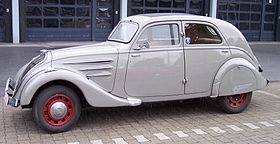Peugeot 402
| Peugeot 402 | |
|---|---|

Peugeot 402 Légère
|
|
| Overview | |
| Manufacturer | Peugeot SA |
| Also called | Peugeot 402B (name modification October 1938) |
| Production | 1935 - 1942 Approx 75,000 produced |
| Body and chassis | |
| Class | Large family car |
| Body style | 4-door sedan Long-wheelbase ‘familiale’ sedan various cabriolets and coupés van and utility versions |
| Layout | FR layout |
| Powertrain | |
| Engine | 1991 cc straight-4 1935–Oct 1938 2142 cc straight-4 Oct 1938–1942 |
| Dimensions | |
| Wheelbase | 2,880 mm (113 in) légère (light) 3,150 mm (124 in) 3,330 mm (131 in) longue / familiale |
| Length | 4,850 mm (190.9 in) standard steel bodied saloon 4,500 mm (177.2 in) - 5,000 mm (196.9 in) (approx) |
| Width | 1,640 mm (64.6 in) |
| Height | 1,580 mm (62.2 in) |
| Chronology | |
| Predecessor | Peugeot 401 |
The Peugeot 402 is a large family car produced in Sochaux, France from 1935 to 1942 by Peugeot. It was unveiled in Paris Motor Show in 1935, replacing the Peugeot 401.
The Peugeot 403, introduced approximately thirteen years after the demise of the 402, can be seen as the older car’s natural heir. (Immediately after World War II the market demanded smaller cars: Peugeot acknowledged this by concentrating during the late 1940s and early 1950s on their 202 and 203 models.)
The 402 was characterized by what became during the 1930s a "typically Peugeot" front end, with headlights well set back behind the grille. The style of the body was reminiscent of the Chrysler Airflow, and received in France the soubriquet Fuseau Sochaux which loosely translates as "Sochaux spindle". Streamlining was a feature of French car design in the 1930s, as can be seen by comparing the Citroën Traction Avant or some of the Bugatti models of the period with predecessor models: Peugeot was among the first volume manufacturers to apply streamlining to the extent exemplified by the 402 and smaller Peugeot 202 in a volume market vehicle range.
Recessed ‘safety’ door handles also highlighted the car’s innovative aspirations, as did the advertised automatic transmission and diesel engine options. Comparisons with Citroën's large family car of the time were and remain unavoidable. In that comparison, the basic underpinnings of the 402 remained conventional, based on known technologies, and presumably were relatively inexpensive to develop and manufacture: it was Citroën that in 1934 had been forced to sell its car manufacturing business to its largest creditor. Sticking to a traditional separate chassis configuration also made it much easier for Peugeot's 402 to be offered with a wide range of different bodies.
...
Wikipedia
